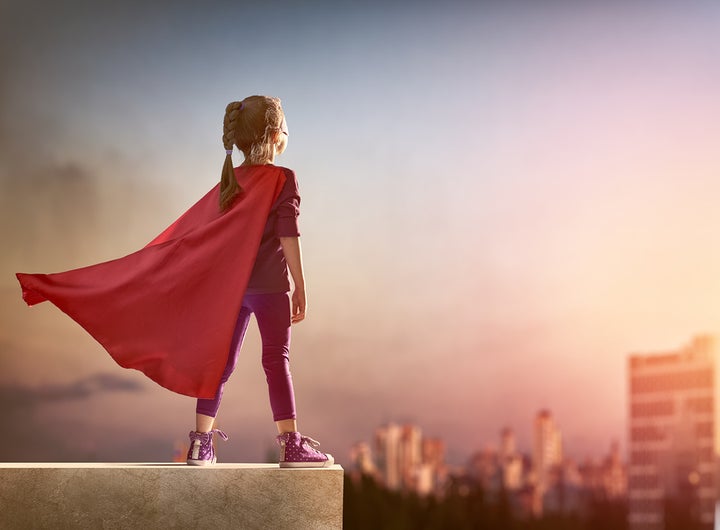
For the first time in 11 years, superheroes have replaced princesses as the most popular Halloween costume. That means, according to a National Retail Federation survey, that you’ll be seeing more of Spiderman and Batman and upstarts Supergirl and Harley Quinn, and maybe a little less of Elsa and Anna.
And that’s a good thing.
Let me start by saying that I’m not anti-princess.
In fact, I cherish the memory of my daughter dressing as Princess Belle as we spent a day in Disney World. She donned a sparkly yellow dress, and her aunt braided her hair just so to create the appearance of a crown. I’ll never forget how my daughter’s eyes shone when a Disney cast member stopped her and asked for her princess autograph. She felt special, treasured even.
But as a child developmentalist, I worry about the impact this moment might have on her in the long run. What was she being adored for?
Princesses are gender-stereotyped characters. They are girly-girls ― often acting affectionate, fearful or troublesome, and rarely stoic, as a leader or the rescuer. Scientists have studied the way that Disney Princesses act and confirmed these gender-typed trends.
My own research shows that children pick up on these trends: Preschool and elementary school kids rated princesses as highly feminine and significantly less masculine ― and they told us that princesses were only for girls.
Why should we care if girls watch movies about princesses and dress up like them on Halloween?
Unfortunately, it’s pretty clear that the characters in kids’ movies and television shows impact how kids act and what rules they think exist for how boys versus girls. In fact, a new study found the more kids watch Disney Princess movies, the more gender stereotyped their play was a year later.
The superhero versus princess debate can even impact kids’ future careers.
One study followed kids from age 10 until age 25 and found kids who liked boy activities were more likely to go into masculine careers ― and masculine skills led to higher salaries. In contrast, the more kids gained feminine skills, the more likely they were to enter typically lower-paid feminine careers. It is almost like they had been princess-tracked.
If you were a hiring manager, would you hire the superhero or the princess?
I don’t want my kids to feel like there is only one way to play. And I definitely don’t want her career options to be limited to those found in the pink toy aisle. I want my daughter to be affectionate, of course, but I also want her to know it’s OK to try being the leader or change the rules on pretend play ― so she’s the one to save someone from peril.
Superhero popularity is good news for kids. In those same interviews where kids told us princesses were largely feminine, kids rated superheroes as having a better mix of both masculine and feminine traits, even though they thought superheroes were more masculine.
By definition, superheroes are strong, and they protect and save people. But kids also noticed that superheroes could be nice and friendly, too. Superheroes’ popularity is evidence that kids don’t need simplified, stereotyped characters.
Clearly, they can handle superheroes having rich and interesting personalities. And because there are fewer rules about how superheroes must act, kids who dress as superheroes for Halloween have more freedom to interpret what it means to them to be a hero.
Children also told us that superheroes were for both boys and girls. This is refreshing, given that today more than ever toys are labeled, color coded and marketed as only being for girls or for boys. It is a strategy that has been lucrative for toy companies, but one that separates boys playing with boys’ toys from girls playing with girls’ toys.
This is a problem because kids don’t learn how to get along with others who are different from them, and it limits the lessons children learn from playing with only half of the toys out there.
But superheroes are different.
Although superheroes traditionally were geared more towards boys, recent efforts have been launched to capture girls’ imaginations. The DC Superhero Girls, a franchise that includes storylines of girl heroes and villains growing up together, is a great example of an attempt to shake the steadfast rule that a toy must either be a girl toy or a boy toy.
Superheroes give boys and girls common ground to play together based on shared interests, rather than always organizing their play groups by gender. It’s possible that superheroes can help bridge the gap that pink-versus-blue toys have created.
In the meantime, princess culture is alive and well. We have an entire generation of girls who grew up with princesses, so one year of superheroes topping the costume list magically won’t erase all worry. And superheroes aren’t without their own issues.
We need more discussion about the violence associated with superheroes, and about how “female superheroes” appear less often and rarely as main characters, and are often scantily clad and overtly sexualized. Of course, the ultimate goal is to have more superhero programs that include equal numbers of male and female superheroes, marketed equally to girls and boys.
But maybe it’s time to give kids the freedom to explore what it means to be nice and friendly, but still willing to use their strength to fight evil forces and protect others. Maybe it’s time to let boys and girls bond over how cool it is that they can all be strong, courageous, and athletic.
And maybe this Halloween, kids all over the country ― boys and girls alike ― can be encouraged to be the superhero and throw on their capes, slap on their wrist bands and rush out to be the ones to save the day.